|
Social Security: Bush's Lies vs. Reality
By
 -
February 2, 2005 -
February 2, 2005

The Bush administration is currently using the same propagandistic
tactics to manufacture a crisis in Social Security as they used
prior to the invasion of Iraq to portray an imminent crisis from
weapons of mass destruction. There were no weapons of mass
destruction and there is no crisis in the Social Security retirement
program. Not only is President Bush clearly demonstrating that the
lesson he learned with the invasion of Iraq was that he could lie to
the American public with impunity, but the major news media of
America is once again proving that it will sit idly by and let the
President say things that are plainly false without calling him on
it.
The link below contains claims made by the Bush administration, as
well as links to President Bush's speeches, from which the following
remarks were taken:
http://www.whitehouse.gov/infocus/social-security/
Bush Claim:
"In 1950, there were 16 workers to support every one beneficiary
of Social Security. Today, there are only 3.3 workers supporting
every Social Security beneficiary. By the time our youngest workers
- those just entering the workforce today - turn 65, there will only
be 2 workers supporting each beneficiary."
Reality:
The reality is that in 1950 the Social Security program was still
in its early stages of implementation, when the majority of people
who had paid into the system had not yet retired. In addition,
changes were made to the program in the 1960s to expand coverage. By
1970 the system had matured to the point where it was operating at a
level where it reflected the true number of retired vs. working
people in the population and accounted for the new changes to the
system. In 1970 the ratio of workers to Social Security recipients
was 3.7 to 1. From 1975 through to today the ratio of workers to
beneficiaries has been around 3.3 to 1. The system has been
operating for the past 30 years with a ratio of around 3 workers to
every beneficiary.
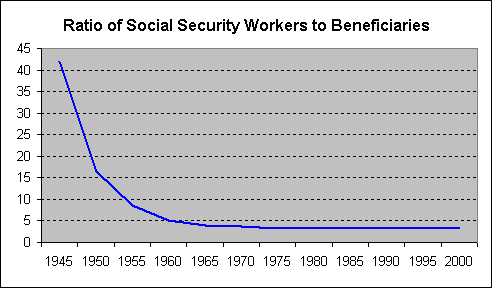
source:
http://www.ssa.gov/history/ratios.html
Bush Claim:
"As a result of these demographic changes, the current system
will not be able to afford to pay the benefits scheduled for our
children and grandchildren without enormous payroll tax increases or
huge benefit cuts. The Social Security payroll tax, which was once
2%, is now more than 12%. Economists calculate that under the
current system, the payroll tax would have to rise to more than 18%
if our children and grandchildren are to receive their scheduled
benefits."
Reality:
The reason behind the possible need to increase the payroll taxes
is not the changing demographics of the population, but rather it is
the increase in income disparity. The fact is that the economy is
continuing to grow, and as long as that happens then there isn't a
demographics problem, however, the fruits of economic growth are
going increasingly to the wealthy, as middle-class and poor workers
face stagnant or declining wages while wages for executives and
superstars climb beyond any rational measure of their contribution
to society. Because of the fact that Social Security taxes are taken
only from wages, and the tax is capped so that it only affects
incomes below a certain level, it means that as income disparity
increases a smaller and smaller portion of our national income is
taxed by the Social Security system, putting a larger and larger
burden on the middle-class and poor.
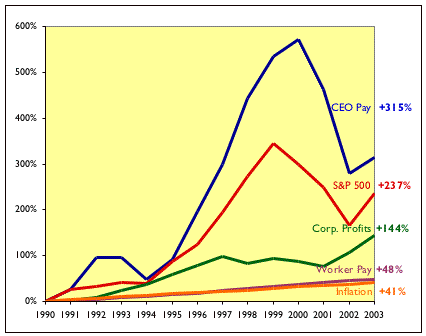
source: http://www.faireconomy.org/research/CEO_Pay_charts.html
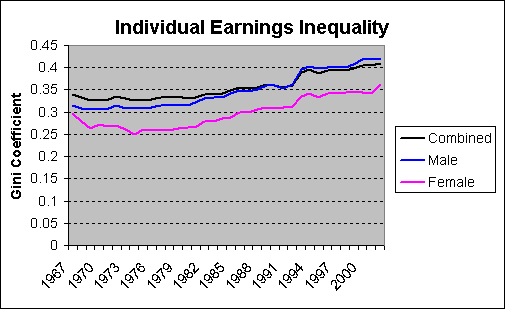
source: http://www.census.gov/hhes/income/histinc/histinctb.html
In 1983 Social Security taxed 90% of American wage income. Today it
only taxes 85% of American wage income, because now 15% of wage
income is above the taxation limit.
Over the past 25 years the productivity of our economy has
increased substantially, which should increase the capacity of our
economy to care for retired workers. The problem, however, is that
virtually all of the productivity gains in our economy since the
early 1980s have been realized by the top 1%, and thus do not
contribute to our ability to sustain retirees through the Social
Security program.
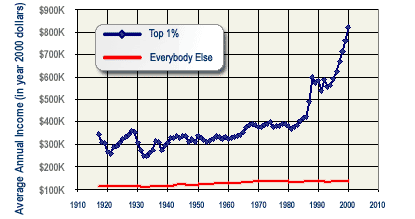
source: http://www.aflcio.org/corporateamerica/paywatch/
Below is a graph demonstrating the portion of national wage income
that is not taxed by Social Security. The portion in red is income
that was not taxed by the retirement or disability portion of Social
Security in 2000.
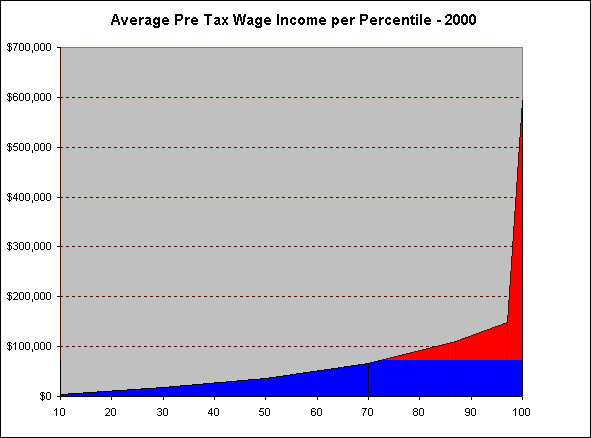
Bush Claim:
"Most younger people in America don't think they'll see a dime"
"If you're 20 years old, in your mid-20s, and you're beginning to
work, I want you to think about a Social Security system that will
be flat bust, bankrupt, unless the United States Congress has got
the willingness to act now"
Reality:
This would in fact be impossible. As long as people work there will
be money to pay Social Security benefits based on the way the system
is set up right now. Social Security benefits are paid from money
collected directly from taxation. The only way that all Social
Security benefits would cease to be paid is if no one worked
anymore, which would either be a result of massive technological
advances that meant people no longer had to work, in which case
Social Security wouldn't matter anyway, or the result of a total
collapse of civilization, in which case no retirement scheme would
be of value.
In reality, there is a problem with the way that Social Security
benefits are calculated. Right now, the scheduled benefits for
retirees in 2050 are 40% higher in inflation adjusted terms than
benefits today. When the statement is made that after the Social
Security trust fund is depleted the system will only be able to pay
out 70% of scheduled benefits, it means that the system
would still be paying out higher real
benefits than retirees get today!
That is certainly not a crisis and not a condition of
bankruptcy.
Bush Claim:
"In the year 2018, for the first time ever, Social Security will
pay out more in benefits than the government collects in payroll
taxes"
Reality:
This is a flat out lie. In 14 of the past 47 years of Social
Security's operation, the program has paid out more than it
collected in payroll taxes. In addition to that, even if it were
true that it would be the first time, it still wouldn't matter. The
trust fund has been intentionally built up over the past 15 or so
years to prepare for the retirement of the so-called "baby boomers".
Additionally, the trust fund is actually still projected to grow
well past 2018 until some time around 2028. All that the 2018 date
signifies is the moment at which some income from interest on the
trust fund may begin being used to pay retirement benefits.
There would be no point in putting any money into the trust fund at
all unless we planned on taking it out at some point. The intention
was never to continually put more and more money into the Social
Security trust fund. It has always been intended that this
money would be used to pay for the retirement benefits of the baby
boomer generation. It is supposed to be used, yet President
Bush presents the fact that this money will be used for its intended
purpose as a sign of failure, when in fact it is not.
The baby boomer generation will begin to retire around 2010 and
some members of that generation will continue to inflate the numbers
of retirees for another 30 to 40 years. This means that the baby
boomer generation is going to be a major budgeting factor for Social
Security to address between the years of around 2010 and 2050.
This is exactly the period of time that the Social Security trust
fund is projected to last without any changes made to the system
whatsoever. The latest projection by the Congressional Budget Office
is that the Social Security retirement trust fund will have a
positive balance through 2052.
In theory, there is little need for a Social Security trust fund at
all. Normally the trust fund should be small, with only enough funds
in it to cover yearly fluctuations in benefit payments. The only
reason that there is a need to build up the trust fund to the large
degree that we have for the past 15 years is to accommodate the baby
boomer generation, which the system is currently on track to do.
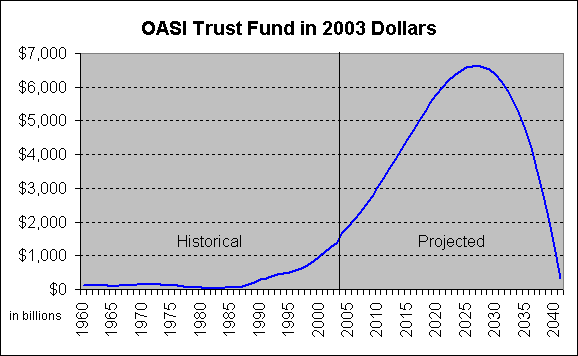
source:
http://www.ssa.gov/OACT/TR/TR04/VI_cyoper_history.html#wp113131
source: http://www.ssa.gov/OACT/TR/TR04/lr6F9-2.html
The above graph is based on reports from the Social Security
Trustees, not the CBO report. As was mentioned earlier, even if the
trust fund is completely depleted, the system will still be able to
pay out higher benefits to each individual than it pays out
today.
For more on Social Security see:
Move over Gingrich, Frank Luntz is the new Goebbels
Getting a grip on Social Security: The flaw in the
system
The Truth
About Social Security
Does Social Security Face a
Crisis in 2018?
|